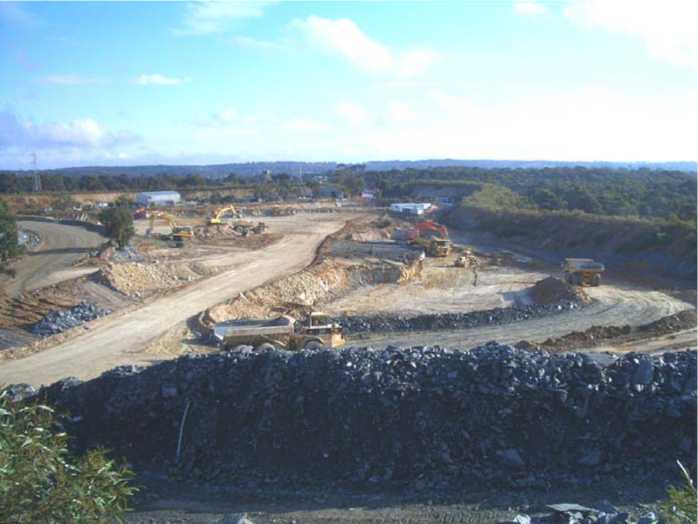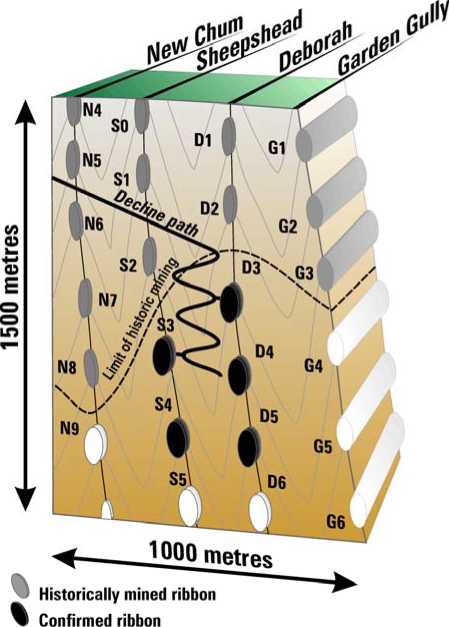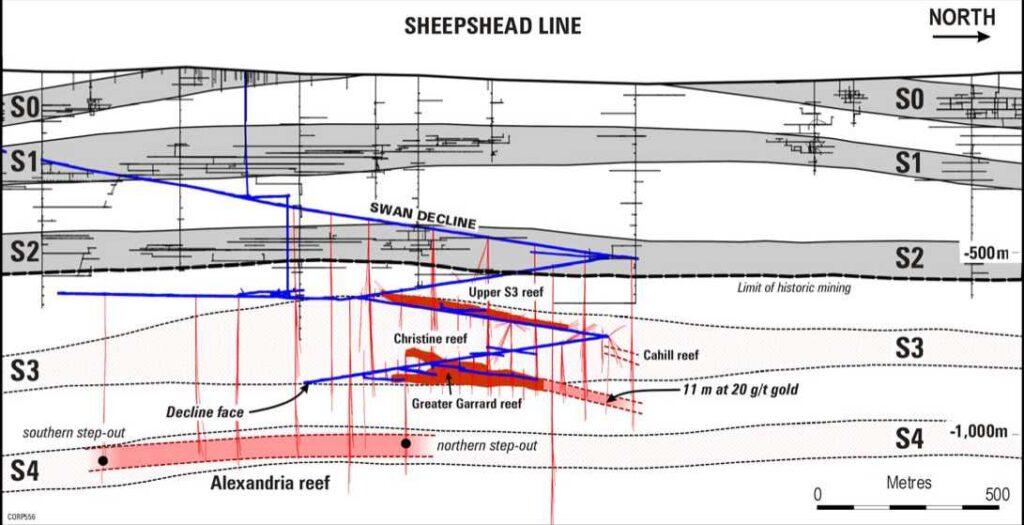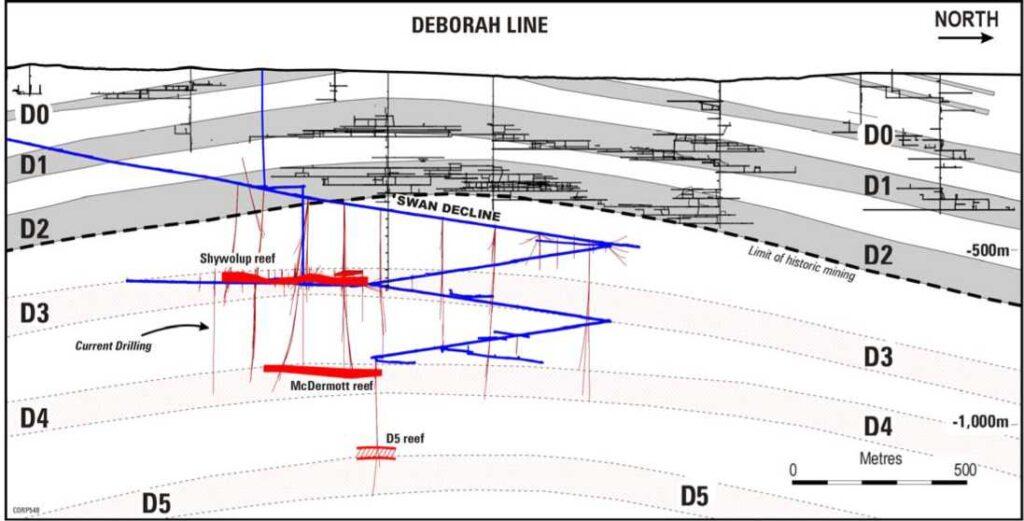QUARTERLY REPORT April – June 2005
Quarterly Report April – June 2005
Key Points
- Plant construction commences on time
- Discovery of large new Alexandria reef
- Greater Garrard reef extended 250 m north with drill intersection of 11 m at 20 g/t gold
Summary
Development
- Plant construction commenced on schedule in May.
- Project is on budget and on time for a June 2006 start.
- Underground development rates are increasing.
Exploration
- Discovery of Alexandria reef over 900 m of strike. This is the largest reef found by Bendigo Mining and it remains open to the north and south. Drilling is continuing.
- Drilling extends Greater Garrard reef by 250 m to the north. This reef contains a large proportion of the Company’s re- serve. Drilling returned 11 m at 20 g/t gold which is similar to bulk-sample grades from within the reef. The reef re- mains open to the north.
- A high-priority target on the D5 ribbon awaits drill testing.
- A fourth drill rig is scheduled to arrive in August.
Corporate
- Cash and liquid assets at 30 June 2005 were $90 million.
No debt.
Bendigo Mining Limited is an Australian company developing one of the world’s largest and highest-grade new gold projects. The Bendigo Goldfield produced some 22 million ounces of gold over a century of mining, and today contains high-grade gold mineralisation of over 11 million ounces beneath the historic workings. Once fully developed, the mine is forecast to produce over 500,000 ounces of gold a year for more than 20 years, which will position Bendigo Mining as one of Australia’s largest long-life gold producers. Phase 1 production is forecast to commence by June 2006 at a rate of 120,000 oz/y.
PRODUCTION STRATEGY
The Bendigo Gold Project is being built in two phases which is planned to deliver gold production of greater than 500,000 oz/y.
Phase 1 is the development of an 850 m deep de- cline (already constructed) and a 0.6 Mt/y plant in the south of the goldfield at the Company’s Carshal- ton site. The plan for Phase 2 is the addition of a northern decline, the underground connection of the two mines, and an increase in total processing ca- pacity to 1.6 Mt/y.
Phase 1 production at a rate of 120,000 oz/y is fore- cast by June 2006. Phase 2 mine planning is under- way in parallel with Phase 1 activities.
PROJECT DEVELOPMENT
Construction of the Phase 1 gold plant started in late May with earthworks. Plant engineering, procure- ment and construction management (EPCM) services are being provided by Ausenco Ltd.
The $53 million plant will incorporate three-stage crushing, including high pressure grinding rolls, grinding, intensive gravity processing, sulphide flota- tion and carbon-in-leach processing of flotation con- centrate.
Plant commissioning is forecast to occur during the June quarter of 2006.
Engineering & Procurement
Detailed engineering design is 50% complete. Com- pleted areas include earthworks, concrete and steel- work for the crushing and grinding areas. Design is on schedule for all other areas of the process plant.
Procurement is about 30% com- plete with orders now placed for all long lead items and are progres- sively being placed for processing equipment and electrical items.
Project financial commitments are at 23%.
Construction
The bulk-earthworks contractor mobilised to site on schedule in late May. Earthwork activity is sched- uled for completion in August.
Concrete foundations are planned to be constructed by October, with steelwork and the delivery of major equipment items to commence in November. Tailings storage facility designs are well advanced.
MINING
Development priorities are set on gaining access to ventilation rise sites and providing additional drill platforms. Development is concentrating on the de- cline and the northern strike drive. Surface activities for the first of the new ventilation rises have com- menced.
The underground mining equipment fleet increased during the quarter with the addition of a second loader and a second development jumbo as well as a third truck.
Underground development of 631 m was completed in the quarter (456 m in the March quarter).
Detailed mine planning is underway in preparation for mining later this year. The upgrade of mine in- frastructure including power, dewatering, emergency response and surface facilities is continuing.
EXPLORATION
The 11 Moz Inferred Resource at Bendigo is sup- ported by the highly repetitive geology of the field.
The geological model (ribbon model) predicts the occurrence of gold-bearing reefs repeating vertically every 200 m. This has been confirmed by explora- tion on the Deborah and Sheepshead Lines (see at- tached long sections).
Current Activity
Exploration this quarter has been very successful.
The delineation of a large new reef in the S4 ribbon, Alexandria reef, and the extension to the Greater Garrard reef, in the S3 ribbon, are two key suc- cesses.

Total metres of diamond core drilled for the quarter was 7,500 m; an 83% increase on the previous quarter. Three underground diamond drill rigs are engaged in the program and a fourth is scheduled to arrive in August.
The following targets are planned to be tested over the next six months:
- S3; Greater Garrard reef: test for northerly exten- sion, in-fill drill
- S4; Alexandria reef: test continuity to the north and south and infill sections
- D5: multiple section test of an excellent structural target for a new gold-bearing reef
Sheepshead line
S3 ribbon
Four gold-bearing reefs are currently identified:
- Upper S3 reef: reef length is 670 m. Further testing is planned.
- Christine reef: reef length is defined at 225 m.
- Greater Garrard reef: Probable Reserves (240,000 t at 10 g/t for 78,000 oz gold) are cur- rently defined over 450 m. Infill drilling this quarter has confirmed a 250 m northerly exten- sion to the reef (see attached long section). Drill- ing returned an intersection of 11 m at 20 g/t gold* which is consistent with bulk-sample grades recorded during development in the same reef, some 200 m to the south. The reef remains open to the north.
Any increase of the Greater Garrard reef is sig- nificant as it can be readily accessed for mining.
- Cahill reef: This small reef is structurally com- plex and requires further drilling.
S4 ribbon
- Alexandria reef: Drilling this quarter delineated a large reef at a depth of 1,000 m, some 150 m below the decline (see attached long section).
The reef is currently 900 m long, with widths of between 3-10 m and approximately 50 m high.It remains open to the north and south.
The Alexandria reef is the largest gold-bearing reef identified to date and it could become a ma- jor new source of production in the next few years. The amount of quartz, arsenopyrite and free-gold observed in the core, indicates that the reef will host economic grade.

Deborah line
D3 ribbon
- Shywolup reef: reef length is defined at 530 m.
D4 ribbon
- McDermott reef: Drilling on one section to the north did not intersect mineralisation. Further testing is planned.
D5 ribbon
- Availability of drill platform has enabled testing of this high-priority target. The first hole of a step- out, some 500 m to the north of drilling com- pleted last quarter, passed approximately 40 m beneath the target. In an encouraging sign, coarse visible gold was observed in minor quartz veining associated with the main bedding parallel structure. Drilling will continue next quarter.
* Bendigo is a high nugget environment and individual gold assays are modified to allow for variable sample vol- umes. The modification is based on statistical comparisons with extensive bulk sampling.
CORPORATE
At 30 June 2005 the Company held cash and liquid assets of $90 million.
The project optimisation study is largely complete.Information should be available by the end of July to announce long term development and financing plans.
The information in this Public Report that relates to Explo- ration Results, Mineral Resources or Ore Reserves is based on, and accurately reflects, information compiled by G.F.
Johansen who is a Member of The Australasian Institute of Mining and Metallurgy. Bendigo is a high nugget environ- ment and based on statistical comparisons with extensive bulk sampling, individual gold assays are modified to allow for variable sample volumes. Mr Johansen is a full time employee of the Company and has sufficient experience hat is relevant to the style of mineralisation and type of deposit under consideration and to the activity which he is undertaking to qualify as a Competent Person as defined in the 2004 Edition of the Australasian Code for Reporting of Exploration Results, Mineral Resources and Ore Reserves.
Mr Johansen consents to the inclusion in the report of the matters based on the information in the form and context in which it appears.



